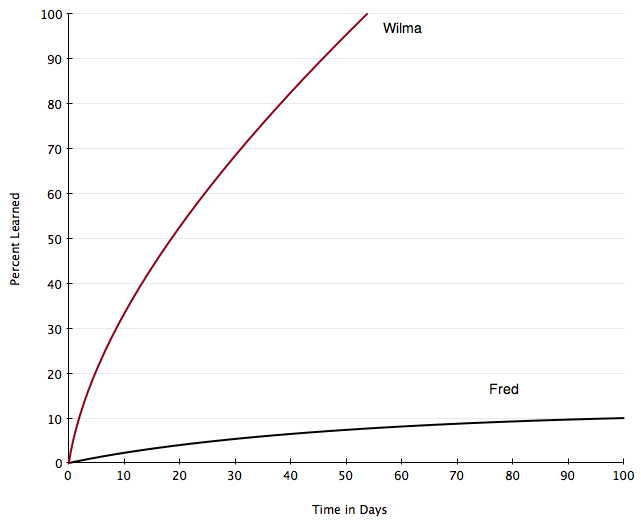This one is a pet peeve.
People engaged in a new activity or hobby will, at some point, be asked to appraise their progress either by a friend or relative. Quite often, the struggle with that process will be accompanied by the following lament, voiced in this case by our fictional friend Fred:
“Yes Barney, I’m enjoying my violin lessons, but it has been hard because the instrument has a steep learning curve.”
Fred is evidently interested in the violin, is enjoying the lessons, but feels that if only the demands of the instrument weren’t so onerous, his progress would be more substantial. Barney, undoubtedly, has a sympathetic look on his face and nods his head gravely once or twice to acknowledge Fred’s toil. Yet there is no need for sadness on either face. Barney should be ecstatic, as Fred has inadvertently indicated that he’s dominating the violin. Yes, dominating. So why the confusion between Fred’s face and his words?
Let us imagine a hypothetical learning curve. It inevitably has two axes, so let’s start with the independent variable along the X axis. For a learning process, the independent variable is time. At Day 0, Fred picks up the violin for the first time ever, and his progress is tracked over the next few days / months / years, depending on his level of dedication (or immaturity).
This leaves us with the responding or dependent variable on the Y axis. As Fred has set out to learn an instrument, what we’re really interested in is how much of the instrument has he mastered? What percent of violin “playing” has he learned? Therefore, we label the Y axis as “Percent Learned” or some similar weighing of learning progress.
Now that we have both axes labeled, we can plot a couple of learning curves as seen below:
On this graph we have two curves, named Wilma and Fred, to represent the divergent trajectories of two different violin players. I’ve exaggerated their learning paths to clarify the point. I think it safe to agree that Wilma has made more significant progress than Fred, as she has achieved the fictional 100% learned status for the violin. Fred, after toiling for 100 days, has mastered roughly 10% of the instrument. But note that the “steep” learning curve is the one that Wilma rode to the top, whereas the shallow learning curve is one that Fred is meandering on. Yet Fred had told Barney that the instrument has a steep learning curve?!
As you can see, a steep learning curve demonstrates that you’re mastering the endeavour in question rapidly. For those lamenting a difficult task, you’re actually riding a shallow learning curve, not a steep one. This misconception is a worm that has bore itself into the sinews of conversation, but next time you’ll be appropriately armed to extract it.
It should also be noted, for the record, that this lesson about the learning curve has… a steep learning curve. And that’s a good thing.

